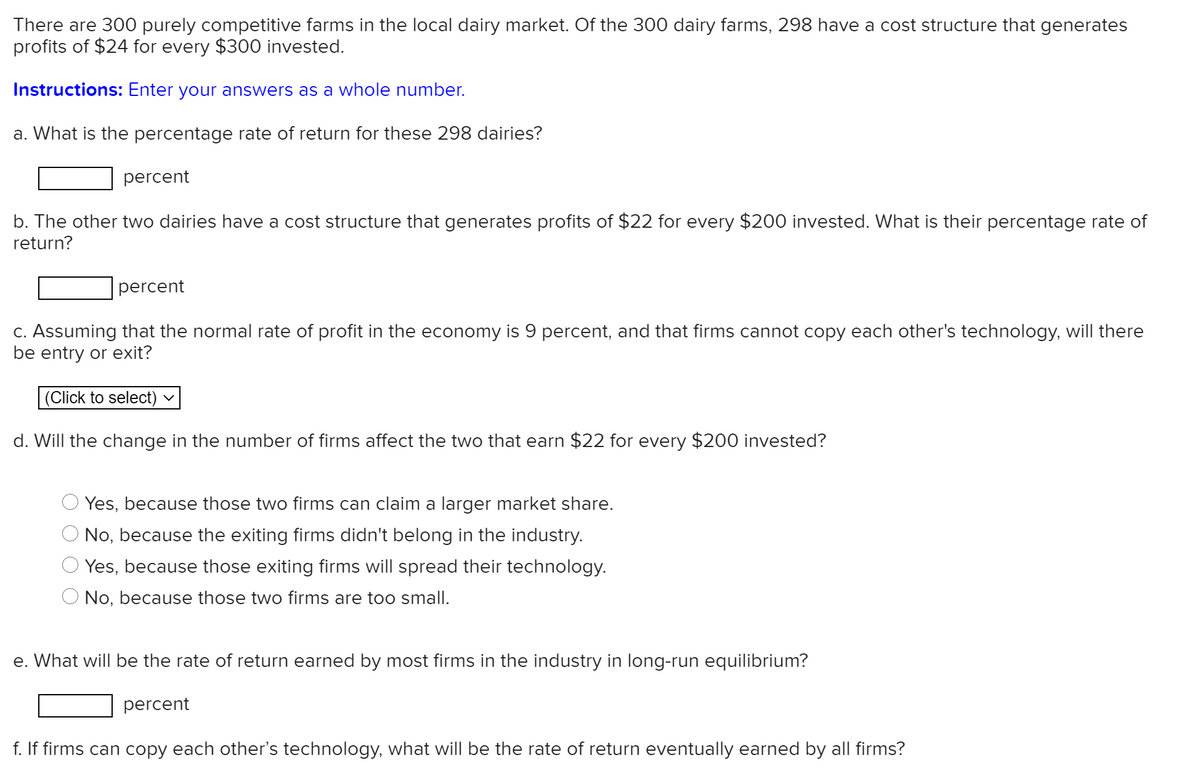There are 300 purely competitive farms in the local dairy market. Of the 300 dairy farms, 298 have a cost structure that generates profits of $24 for every $300 invested. Instructions: Enter your answers as a whole number. a. What is the percentage rate of return for these 298 dairies? percent b. The other two dairies have a cost structure that generates profits of $22 for every $200 invested. What is their percentage rate of return? percent c. Assuming that the normal rate of profit in the economy is 9 percent, and that firms cannot copy each other's technology, will there be entry or exit?
There are 300 purely competitive farms in the local dairy market. Of the 300 dairy farms, 298 have a cost structure that generates profits of $24 for every $300 invested. Instructions: Enter your answers as a whole number. a. What is the percentage rate of return for these 298 dairies? percent b. The other two dairies have a cost structure that generates profits of $22 for every $200 invested. What is their percentage rate of return? percent c. Assuming that the normal rate of profit in the economy is 9 percent, and that firms cannot copy each other's technology, will there be entry or exit?
Chapter11: The Firm: Production And Costs
Section: Chapter Questions
Problem 3P
Related questions
Question
Info in images

Transcribed Image Text:There are 300 purely competitive farms in the local dairy market. Of the 300 dairy farms, 298 have a cost structure that generates
profits of $24 for every $300 invested.
Instructions: Enter your answers as a whole number.
a. What is the percentage rate of return for these 298 dairies?
percent
b. The other two dairies have a cost structure that generates profits of $22 for every $200 invested. What is their percentage rate of
return?
percent
C. Assuming that the normal rate of profit in the economy is 9 percent, and that firms cannot copy each other's technology, will there
be entry or exit?
(Click to select)
d. Will the change in the number of firms affect the two that earn $22 for every $200 invested?
Yes, because those two firms can claim a larger market share.
No, because the exiting firms didn't belong in the industry.
Yes, because those exiting firms will spread their technology.
No, because those two firms are too small.
e. What will be the rate of return earned by most firms in the industry in long-run equilibrium?
percent
f. If firms can copy each other's technology, what will be the rate of return eventually earned by all firms?
Expert Solution
This question has been solved!
Explore an expertly crafted, step-by-step solution for a thorough understanding of key concepts.
This is a popular solution!
Trending now
This is a popular solution!
Step by step
Solved in 4 steps

Knowledge Booster
Learn more about
Need a deep-dive on the concept behind this application? Look no further. Learn more about this topic, economics and related others by exploring similar questions and additional content below.Recommended textbooks for you

Exploring Economics
Economics
ISBN:
9781544336329
Author:
Robert L. Sexton
Publisher:
SAGE Publications, Inc

Microeconomics: Private and Public Choice (MindTa…
Economics
ISBN:
9781305506893
Author:
James D. Gwartney, Richard L. Stroup, Russell S. Sobel, David A. Macpherson
Publisher:
Cengage Learning

Economics: Private and Public Choice (MindTap Cou…
Economics
ISBN:
9781305506725
Author:
James D. Gwartney, Richard L. Stroup, Russell S. Sobel, David A. Macpherson
Publisher:
Cengage Learning

Exploring Economics
Economics
ISBN:
9781544336329
Author:
Robert L. Sexton
Publisher:
SAGE Publications, Inc

Microeconomics: Private and Public Choice (MindTa…
Economics
ISBN:
9781305506893
Author:
James D. Gwartney, Richard L. Stroup, Russell S. Sobel, David A. Macpherson
Publisher:
Cengage Learning

Economics: Private and Public Choice (MindTap Cou…
Economics
ISBN:
9781305506725
Author:
James D. Gwartney, Richard L. Stroup, Russell S. Sobel, David A. Macpherson
Publisher:
Cengage Learning

Managerial Economics: A Problem Solving Approach
Economics
ISBN:
9781337106665
Author:
Luke M. Froeb, Brian T. McCann, Michael R. Ward, Mike Shor
Publisher:
Cengage Learning

Principles of Economics 2e
Economics
ISBN:
9781947172364
Author:
Steven A. Greenlaw; David Shapiro
Publisher:
OpenStax